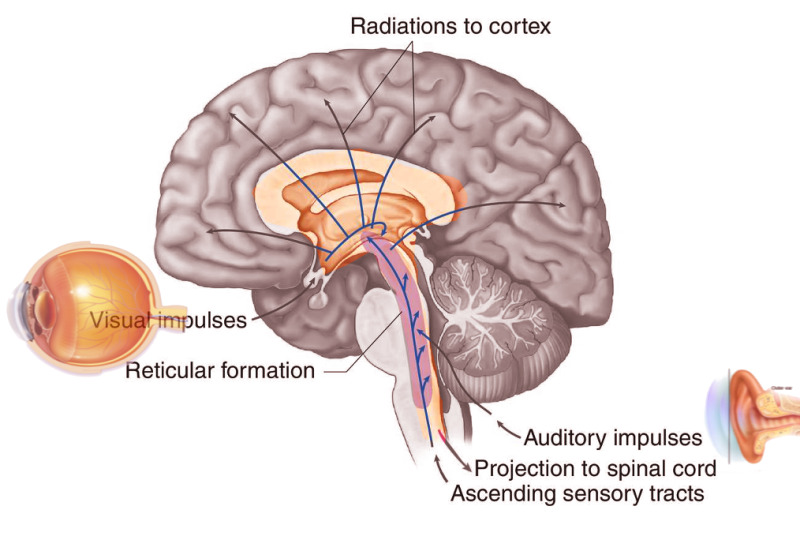Acknowledging the presence of a scarcity mindset is the first step towards breaking free from its restraints. An alternative is to develop an abundance mindset, being open to practical insights and drawing on well-known concepts and examples. Exploring the Law of Attraction and its impact on success helps to lift the veil, revealing the transformative power of positive thinking and intentional focus on opportunities.
The Law of Attraction: Balancing Mystique with Reality
While “The Secret” popularized the Law of Attraction, we’ll refrain from delving into controversial aspects and focus on its practical implications. Whether viewed as mystical or not, there is undeniable evidence that individuals with a positive mindset, actively seeking opportunities, tend to attract success. Conversely, those with a negative outlook and a scarcity mindset face challenges in realizing their goals.
Reticular Activating System:
The Reticular Activating System (RAS) is a fascinating aspect of our brain that filters information based on our focus and goals. Let’s delve into a real-life example to illustrate how the RAS works and how you can leverage it to enhance your life, like when you decide to get a new car.
New Car Example:
Before Decision:
- Initial Unawareness: Imagine you’re considering buying a specific make and model of a car, let’s call it the “Blue Horizon.”
- Limited Observation: Before contemplating this car, you rarely notice it on the road. It exists, but it doesn’t register prominently in your awareness.
After Decision:
- Decision-Making: You decide that the Blue Horizon is the car you want to purchase. Your brain now recognizes it as significant due to your decision-making process.
- RAS Activation: Your Reticular Activating System kicks in. It’s like programming your brain to be on the lookout for the Blue Horizon.
Observing the Shift:
- Everywhere You Look: Suddenly, you start seeing Blue Horizons everywhere. They seem to appear on your commute, in parking lots, and even in your neighborhood.
- Heightened Awareness: The car was always there, but your heightened awareness, courtesy of the activated RAS, makes it more noticeable. Your brain filters out irrelevant information and zooms in on what you’ve deemed important—the Blue Horizon.
Leveraging RAS for a Better Life:
**1. Setting Clear Goals:
-
- Define your goals clearly. Whether it’s related to career, personal development, or relationships, be specific about what you want to achieve.
**2. Visualization:
-
- Visualize your goals regularly. Imagine your desired outcomes vividly. The more detailed and emotionally charged the visualization, the more likely your RAS will pick up on relevant cues.
**3. Positive Affirmations:
-
- Use positive affirmations that align with your goals. Affirmations create a positive mindset and signal to your RAS what to focus on.
**4. Consistent Focus:
-
- Stay consistently focused on your goals. The more attention and energy you devote to your objectives, the more your RAS will actively seek opportunities and connections related to them.
**5. Selective Attention:
-
- Understand that you can’t focus on everything. Be selective about your priorities. By narrowing your focus, you guide your RAS to filter information that aligns with your chosen path.
**6. Repetition and Reinforcement:
-
- Repetition is key. The more you reinforce your goals through thoughts, actions, and habits, the more effectively your RAS will work to align your experiences with your aspirations.
**7. Gratitude Journaling:
-
- Keep a gratitude journal. Acknowledge and appreciate the positive aspects of your life. This practice reinforces positive thinking and signals your RAS to notice and attract more of those positive elements.
The Reticular Activating System serves as a powerful ally in achieving your goals and enhancing your life. By consciously directing your focus, setting clear intentions, and maintaining a positive mindset, you can harness the potential of the RAS to notice opportunities, connections, and experiences that align with your aspirations.
The Power of Positive Thinking:
At its core, developing an abundance mindset involves thinking positively and actively seeking positivity in life. Numerous studies, such as those conducted by psychologist Martin Seligman on positive psychology, support the idea that a positive outlook contributes to overall well-being and success. Individuals who actively look for solutions and opportunities are more likely to attract positive outcomes.
The Challenge of Subconscious Patterns:
The subconscious mind may resist change even with conscious efforts to adopt a positive mindset. This resistance can manifest as self-sabotage, hindering progress towards set goals. As highlighted by behavioral psychology research, awareness of these patterns is crucial to prevent reverting to old, limiting beliefs.
Addressing Subconscious Resistance:
Individuals must actively work on changing internal beliefs and mindsets to counter subconscious resistance. Developing an abundance mindset involves challenging deep-seated notions about deserving success and financial well-being. By doing so, the subconscious mind can be aligned with positive goals, fostering an environment where success is attainable and welcomed.
In the pursuit of personal and financial growth, cultivating an abundance mindset is a transformative journey. Supported by real-world examples and grounded in the practical implications of the Law of Attraction, this guide provides actionable steps for individuals to break free from the shackles of scarcity thinking. Embracing positivity, intentionally seeking opportunities, and addressing subconscious resistance are critical elements in developing an abundance mindset that paves the way for a more fulfilling and successful life.
References:
- Seligman, M. E. P. (2002). Authentic Happiness: Using the New Positive Psychology to Realize Your Potential for Lasting Fulfillment. Free Press.
- “The Secret” (2007). Film by Rhonda Byrne.
- Loehr, J., & Schwartz, T. (2003). The Power of Full Engagement: Managing Energy, Not Time, Is the Key to High Performance and Personal Renewal. Free Press.
